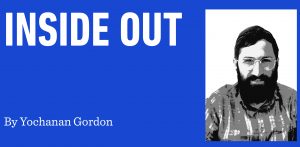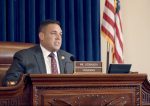
On Tuesday, November 14, 2023, I was on a bus returning from Washington, D.C. where close to 300,000 of our brethren and supporters of Israel gathered on the National Mall in front of the White House to rally in support of the hostages who have been held captive in the murderous hands of Hamas for 38 days.
While the President has done his best in throwing his political weight behind the plight of Israel, earlier today it was reported that 400 members of the government submitted a dissenting letter in opposition to the president, demanding a ceasefire.
A similar hostility has been playing out in microcosm in our cloistered community with regard to supporting the rally. Where initially the worldwide Jewish community came out in support of the Washington rally, some communities opposed it from the get-go. And still others that withdrew support in light of a program that featured actresses, a pastor, and a news commentator among other influential persons.
There was a cartoon I loved during my upbringing that was called, “Transformers.” Their subtitle was: “More than meets the eye.” For the people of the book who know more than anyone else how to plumb the depths of a statement to unearth the kernel of truth, we seem incapable of cutting through the outer layers of what looks on the outside like a political protest, but is in actuality a gathering of prayer and Psalms.
I wonder about all those who initially lent their support to the rally but later recanted after seeing the program. What was it that they were in support of? And what about the program caused them to withdraw their support? For my chevra at Khal Mevakshei HaShem, under the auspices of Harav Yussie Zakutinsky, we were going to a place where the Shechinah HaKadoshah rested. The Mishnah in Avos states: “The Shechinah rests on all convocations of ten.” How much more so in a gathering of hundreds of thousands. As our sages teach: “B’rov am hadras melech.” When Hashem sent Moshe to speak to Pharaoh to begin unfolding the process of redemption, Moshe said: “I am not a man of words.” Hashem told Moshe to take Aharon to act as his spokesman.
The tandem of Moshe and Aharon correspond to the voice and words respectively. The root of Moshe’s soul is pre-lingual and it is Aharon’s job to interpret it to give verbal expression to those sound waves.
The Mei Hashiloach of Izhbitz taught that the whole world is akin to a dream that is seeking interpretation, and the reality is based on the interpretation we impose on it. When a political talking head stands at the podium and speaks about dreams of peace and coexistence, about a time when mankind will lay down their instruments of war, what are they really saying? They are saying, “Ani shalom v’chi adaber heimah lamilchamah—I am peace and whenever I speak, they declare war.”
When a mother of a child held in captivity stands in front of 300,000 people and bares her heart, describing the pain and anguish she has been living with ever since that fateful day, she is recitation the same pain that King David described in his own words.
This is precisely the message of Rebbe Nachman of Breslov in Torah 282 where he writes: “Know, that everyone needs to give each person the benefit of the doubt. We need to probe the depths of the acts of a complete rasha and unearth within them a redeeming element; for in that element, he is no longer a rasha and in so doing, you deliver redemption to you, to him, and to the entire world.”
Do you see what is at stake? It is painful to say but it almost feels to me as if people would rather claim their own innocence and righteousness rather than find merit in the acts of people that outwardly they don’t see eye to eye with. But Rebbe Nachman is telling us that this is the way to global redemption, and out of the painful situation in which we find ourselves. The Torah tells us that the Yidden in Mitzrayim cried out to Hashem and He heard their cries. However, the Jews in Mitzrayim were short of breath and were only able to grunt without articulating any coherent prayers. So, what was it that G-d listened to? This was the role that Aharon played in being able to put words into the sounds of the people who cried out in great pain.
There is a tradition to recite Psalm 119 whenever someone is in dire need of a cure. The chapter contains 22 stanzas, each of which contains seven verses. The number seven, which corresponds to nature, likewise corresponds to defined structures; whereas the number eight leaves the possibility to take the letters and form the correct words that are required to bring about salvation.
In hearing this perspective, I joked: “If only Americans who got together every year for Thanksgiving knew that they could interpret the words of their politically divergent family and create a reality for it. That would save them a lot of heartache.” We get together a lot more often than just once a year for Thanksgiving, and it would greatly help us by seeing things from their inner core rather than how they look on the outside. For anyone who has a hard time seeing things this way, it is an indication that they don’t see the world as an extension of Torah. All of life are sugyos in Gemara. There are some people or situations that represent the initial premise of the Gemara; others who represent the conclusion, and so forth. The Zohar says that Hashem created the world by looking in the Torah. This means He looked into the Torah and saw an entire world in there. It’s our job to interpret the people and places that we interface with back to its root in the Torah.
I decided to say Tehillim on Tuesday as I stood amongst the masses while the speakers gave their presentations, hoping to comingle the words of King David with their own in order to train myself to hear his words in theirs. The samech-mem, the yetzer ha’ra, wouldn’t inconvenience himself to come to the Washington Rally. Whatever external reasons that compelled the zealous members of our community to recant their support of the rally are the same reasons why the samech-mem wouldn’t bother showing up. As a result, the words of prayer we uttered are capable of reaching their intended mark in the highest of heights without obstruction. The Mishnah at the end of Taanis famously states that the Jewish people are Hashem’s mikvah. Coming to Washington, D.C. to stand shoulder to shoulder with hundreds of thousands of Jews was like immersing in the pure waters of the Jewish people. We stood together, praying as one. What about that warrants criticism?















Hi. I am happy you have a rabbi that told you to go. However, to claim that the Schecina was there based on the mishna of 10 is grossly a misinterpetation. The beit hamikdash had a mechitza and that was where the Schechina rested why couldn’t they make a small mechiza there? 2. Whatever you think it was going to accomplish it won’t? congress members didnt care much that there was a rally it wont change their mind, listing to left wing people won’t changes their mind. Just admit the rally end up being a feel good purpose and nothing else. 3. the Jewish federation chose not to choose any orthodox rabi to speak including yours but wanted to make sure they filled the check box of any other diversity requirement ask yourselves that? 4. sometimes the yetzer hara will think we are doing a mitzvah in order to prevent other bigger mitzvas -again if you had any proof that this rally accomplished anything it would be a mitzvah but it took away from other peoples mitzvahs and torah 5. when the pastor chanted we are one did you scream we are one, when van jones said peace onto the gazans and when the others called for peace and ceasefire did you chair that.
I believe everything you wrote was trying to convice yourself it was a mitzvah instead of a wasted time
The important point which you are glossing over is the Torah of Rebbe Nachman of Breslov in 282. We have a responsibility to find the redeeming spark in every person and every situation which brings redemption individually and collectively.
I too initially questioned the lineup put out by the federation but was thankful for this perspective so that an unprecedented opportunity of standing amongst 300,000 people not go to waste. The Izbitzer writes that this world is a dream which seeks an interpretation; you can look at it in its most external manifestation or you could analyze it, like one would a dream, which possesses contradictory elements, in trying to make sense of it.
There is an element of pain in the sense that G-d cannot express himself openly and that one needs analytical and redeeming eyes in order to see the Godliness beneath the surface; that is the pain of shechinta b’galusa but the shechina is nonetheless there and it behooves us to be there regardless of the antenomian elements within it.
The Gemara writes of a time Rashbi sent his son Rebbe Elazar to get a blessing from the chachomim and it seemed to him that they were cursing but he explained that they were couching their blessings in hidden terms. We have to be able to look at the world around us, which G-d created through Torah, in the same manner. If we are able to probe the depths in the statements of Torah we should be able to redeem the people and the circumstances which are all a part of Torah.